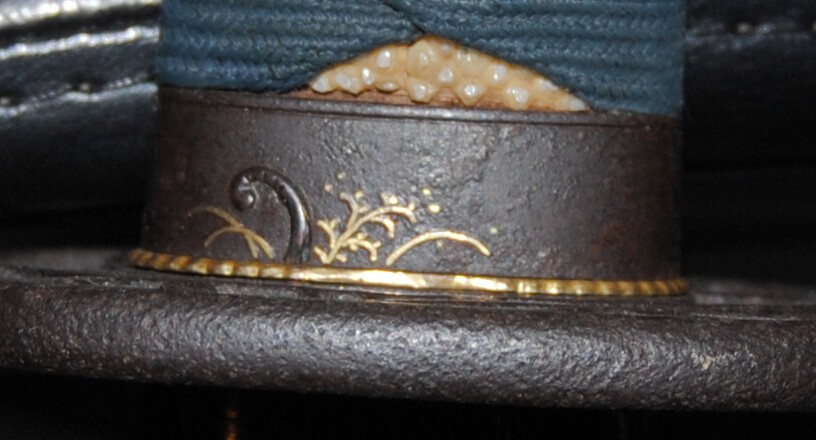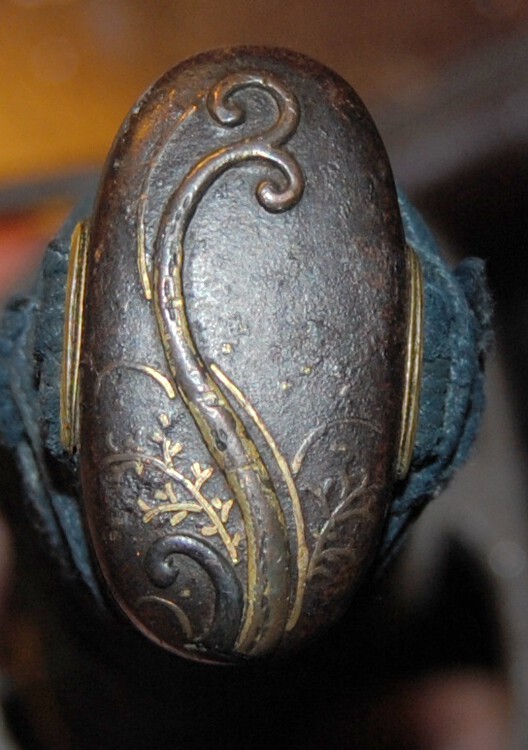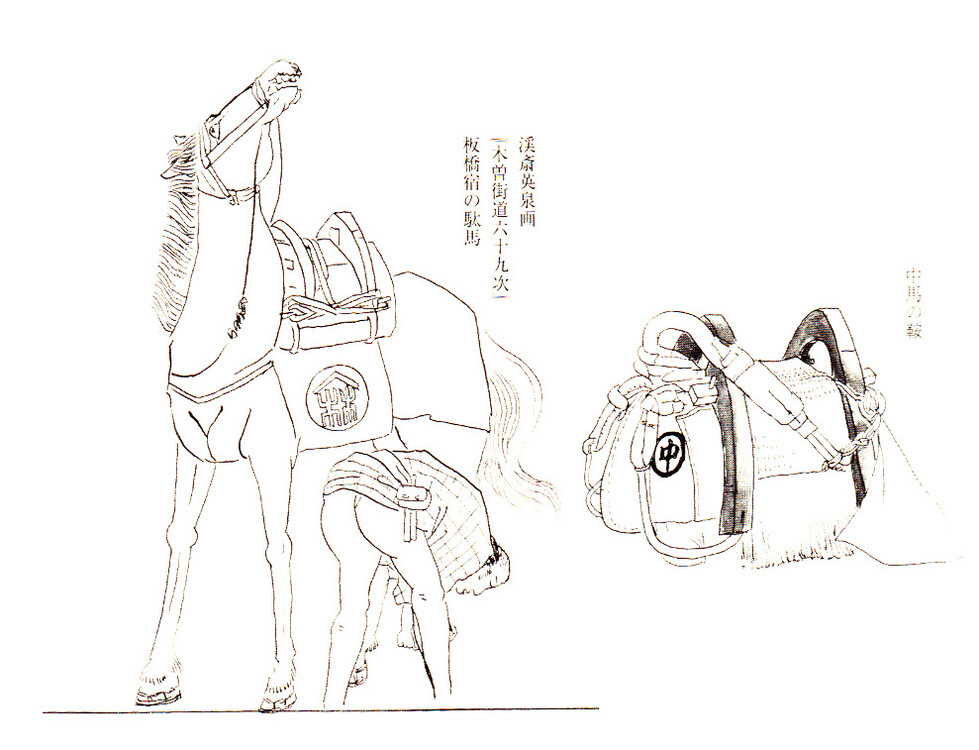
IanB
Members-
Posts
1,778 -
Joined
-
Last visited
-
Days Won
23
Everything posted by IanB
-
Interesting karuta tatami armor.
IanB replied to estcrh's topic in Auctions and Online Sales or Sellers
Eric, Indeed a very interesting tatami dou. The lavish use of applied kiritetsu is unusual as is the position of the gilt ring - normally that would be on the right side not the left. The dou is also interesting in not having a gattari for a sashimono. This gent does seem to get some interesting items and is generally cheap, but I have never had the courage to bid on anything. Ian Bottomley -
This Week's Edo Period Corner
IanB replied to Bugyotsuji's topic in General Nihonto Related Discussion
-
This Week's Edo Period Corner
IanB replied to Bugyotsuji's topic in General Nihonto Related Discussion
Piers, I don't know if this one will do, I bought it for a tanto of mine without checking the size and found it far too small. The kozuka measures 7.8cm x 1.1cm and the blade is 10.3cm. The design is in simple silver nunome. Ian Bottomley -
Justin, Not an o-yoroi in fact but a copy of an okegawa nimai-dou gusoku: that is a two piece dou made up of horizontal plates. It was a very common style during the Sengoku Period for all ranks since it could be made up quite quickly from relatively small pieces of iron. The way it is constructed also allowed the maker to get a good shape quite easily by trimming the plates to lenticular shapes and positioning the rivets in the right. As I get older I am beginning to realise that these sorts of considerations had a profound influence on armour styles. Ian Bottomley
-
Justin, You say you have bought an 0-yoroi. Technically this style of armour has the dou in two pieces: a section of lamellar that runs round the front, left side and back, with a separate solid plate attached to the right of the body before the rest is put on. It is also characterised by having only four, trapezoidal, kusazuri and the entire front covered in a sheet of stencilled leather. If yours is like that it is an o-yoroi. I did notice one on eBay so maybe that is the one you have acquired. For many of these Meiji and later armours I have noticed their makers have used fabric printed with traditional leather patterns instead of the more expensive stencilled leathers. These latter varied greatly over the ages, but a lot are based on the 'shishi ko sakura' design and incorporate a date in their design. Despite the name, they are actually decorated with shishi and foliage, generally in blue with flowers, that are peonies not cherry, in red. The dates do not indicate when the leathers were made but when that particular design was licensed for manufacture. Ian Bottomley
-
The use and or name of these items.
IanB replied to estcrh's topic in General Nihonto Related Discussion
Eric, The first is a cartridge box carried on the belt. The second a powder flask. The third looks like a powder charge holder. No doubt Piers will fill in the names. Ian Bottomley -
Yimuyin, Although of no help at all in identifying your tsuba, I have a sword mounted with an unsigned fuchi / gashira that may well have been originally mounted with your tsuba. They are in iron, inlaid with shakudo and gold with additional pieces in nunome. Ian Bottomley.
-
All, I would have thought that an early tsuba maker would really have preferred to use the softer iron rather than a steel. Iron would have been perfectly suitable for the purpose and be much kinder on the tools used to pierce and chisel the work. I would suggest that many a tsuba maker cursed when running into a hard spot - I know I have when working iron castings which can destroy the edge of a steel tool in seconds. As for the 'wear', some is bound to happen through handling and rubbing, but simple oxidation must have also played a large part. Ian Bottomley
-
This Week's Edo Period Corner
IanB replied to Bugyotsuji's topic in General Nihonto Related Discussion
Piers, There is an Army Museum in Lisbon but I've never been or really asked those who have. So you are setting out in reverse of the events of 1543 - taking guns back to the Portuguese. Nice thought that. Ian Bottomley -
Eric, Yup, exhibitions can be a nightmare. I started planning for the Tokugawa Ieyasu exhibition in 1998 and it finally took place in 2005. My original plan was to try and bring together all the surviving armours of the commanders at Seki ga Hara and hold it in 2000, the 400th anniversary. Surprisingly this does not seem to have ever been done. Sadly it wasn't to be. However, what finally emerged was a nightmare, compounded by the fact that many lenders insisted their objects could only be exhibited for half the time. This meant a lot of re-jigging so that each half of the exhibition told the same story. Ian
-
Eric, Thank you for posting the pictures. There is some very nice items there. I especially love the kusari armour with the eyes looking at you. It looks as if it has a kind of haidate divided into sections like a kendo tare. I don't think I have seen that before. Again thanks for the images. Ian Bottomley
-
Werner, As Andreas has said, the smith's name is largely lost through shortening. I read Kashu Kanazawa ju Hiro (?)emonjo Fujiwara .... AS Andreas says, the smith is almost certainly Takahiro. Ian Bottomley
-
Gentlemen, I take your point that a kogatana can be 'started' from its pocket by the left thumb. In fact, I've tried it with the kogatana on the omote, by turning the sword upside down, and it is just as easy to curl the fingers under the saya and use the thumb. It is then however a bit akward, but not much, to grasp the kogatana with the right hand around the tsuka and tsuba. I suppose my comment was coloured by my Western attitude of 'having it all on show at the same time', instead of the Japanese preference for revealing things gradually so that the mind has time to assimilate them. Ian Bottomley
-
Ford, I would suggest you are forgetting that any Sengoku bushi of rank had a back-room crew whose function was to look after him and his gear. Even if he decided to fight on foot, he would have a horse to get to the action. Some of these attendants, grooms and 'servants' would wear swords, maybe in some cases tachi, in others koshigatana and uchigatana. During the Edo period, it was actually laid down in statute how many attendants a samurai of a particular rank needed when he travelled abroad. There were grooms to lead his horse, armour carriers and lower rank samurai with spears - and that was just to go to the fish and chip shop. :lol: :lol: I've probably said this before, but when I took over the Japanese collection at the Royal Armouries there was a strange item that puzzled me. Imagine and iron rod, about 10" long and 3/8" diameter that had what looked like an arrowhead, without its tang, formed on one end the other being rounded. For quite a while I thought it was an attempt by someone to start hacking an arrowhead out of the solid, but the rounded finished end suggested otherwise. It was resolved when I saw another, albeit with Higo style overlay in gold on the shaft, in a 1960's antiques catalogue from Japan that had somehow strayed into the Museum's library. It was described there as a bashin. Now this wasn't for wearing in a sword but obviously kept in the stables or carried by a groom. I would suggest that the sukashi tsuba, bashin, and all such, may have been for swords worn by these lesser mortals, which was subsequently re-used like so much Japanese material was, and ended up on later swords to puzzle us. Ian Bottomley
-
Gentlemen, A very interesting thread. Glancing through the catalogue of the sword exhibition at the Tokyo Museum in 1997 I note that both the kogai and kogatana were fully evolved in their shapes, and in their customary places in the scabbards of some koshigatana, as early as the Kamakura period. The same catalogue also shows a koshigatana from the Muromachi with a kogatana in the omote face of a scabbard which suggests the positioning of these implements was not rigorously established at that stage. It has always struck me as rather odd that such a decorative item as a kozuka should be hidden away on the rear of an Edo period wakizashi, particularly for those swords whose other mounts are obviously designed to impress. In this position they were unseen unless the sword was removed from the obi, and subject to the maximum amount of rubbing against the clothes. Perhaps that is why so many kozuka are so badly worn. As for uchigatana, the story of their evolution still remains somewhat enigmatic to my mind. Certainly, common soldiers were issued with them during the later Muromachi, but they are described and named as early as the Heian. We generally accept that they were worn edge upwards through the obi, but have a look at the portrait of Honda Tadakatsu seated on his camp stool wearing his black armour. He has his tachi, with a diamond shaped tsuba, and his uchigatana with a mokko shaped tsuba but it is being worn edge downwards. He also has a tiny tanto / koshigatana that you don't notice until you look carefully. I suspect they all did what seemed right to them at the time. I suspect we are imposing the formalities of the Edo period onto more distant eras. Ian Bottomley
-
John, As you know, I am an ignoramus when it comes to tsuba, but two points struck me. Sawari is a very hard alloy with I suspect quite a high melting point (perhaps Ford might know the approximate value). It was used extensively on armour, particularly in Kaga, fused on as droplets to represent dew or rain (- and as gama hada on tsuba?). But, they had a lot of trouble pulling the trick off. To be successful they had to just fuse the metal enough to stick but not to run. I have a pair of kote where the guy has just overheated the plates and on some the alloy has flashed over the surface. There is a helmet, by I think Ryoei, in the Armouries where exactly the same has happened. It represents an egg plant with the stalk and sepals(?) at the top and leaves forming the peak - all in one piece. Can you imagine his mood when the sawari flashed over the surface after all that raising. - are there many swear words in Japanese? The other point is about your tsuba. The wear to the lower part has all but removed the chiseled lines - that has had a lot of use. Ian Bottomley
-
Meant to write 'We don't get members like those in our ToKen ' Must have got the shakes. Ian Bottomley
-
We don't get members like those in out ToKen Ian Bottomley
-
Genuine Kosherei with Chinese blades
IanB replied to Lindus's topic in General Nihonto Related Discussion
Roy, Some years ago a Nottingham based dealer bought the contents of a warehouse in Manchuria. I was lucky enough to see some of the items months after it arrived in the UK and after several Japanese sword dealers had been through the haul. There were hundreds of Mauser and Luger pistols, all destined for the US, thousands of venerable old Mauser rifles that had served in several armies before reaching Manchuria. These were being scavenged to make some of them workable before being passed on to some other tragic theater of war. Finally there was the rump of what had been many hundreds of gunto, all smothered in foul grease and in various stages of decomposition. I had a look through a few dozen but it was obvious there was going to be little of value left. I often wonder what happened to the residue. As for the Chinese blades in real gunto mounts, I have seen one I finally decided was a Chinese blade in a koshirae that contained real Edo period mounts that is reputed to have come out of Japan. The scary thing is that even now I cannot say for definite it was a Chinese copy - all I can say is that there was something not quite right about it. I know some Iaito dealer has had a bunch of Chinese trained in Japan and they are crashing out blades for him at a cheaper rate than he paid Japanese smiths. I suspect the sword I saw was one of these. Ian Bottomley -
I need help learning how to translate meis.. and this katana
IanB replied to Eziodjinn's topic in Translation Assistance
Tyler, I know just how frustrating it can be and still remember the almost hysterical pleasure I had when I finally read my first tang. Not wanting to spoil your fun, allow me to give you a few hints. That side with most characters on has the usual construction of Province, town, living at, something, swordsmith's name, made this. Now remember provinces always have two character names and are often abbreviated (still two characters). In this case the town is a single character. That should get you going on that side. What the 'something' is I will not say yet. Almost always, the characters on the other side will be a date. This is two characters for the year period, numbers indicating what year in that period, the character for year, numbers for month, character for month and then usually 'auspicious day' or just the character for day. That should help you sort that side out. Good luck and let us know how you get on. Ian Bottomley -
Not Nihonto but it is Samurai
IanB replied to jason_mazzy's topic in Auctions and Online Sales or Sellers
Eric, A wonderfully complete outfit. It is a pack saddle - presumably for use in the daimyo gyoretsu. Ian Bottomley -
George, Sorry, but you are wrong. A pentagram, and separately, two palm branches below a crown, occur on a wheel lock pistol belonging to an Italian nobleman in the Royal Armouries collection. His armour, with the same devices, is in the armoury in Torino and was acquired in the 19th century. Can't remember his name off hand but I seem to remember he was big in the Church (would you believe). Ian Bottomley
-
Humid vs. Arid conditions
IanB replied to Justin Grant's topic in General Nihonto Related Discussion
Don't forget guys that the lacquer on the saya and any textiles need around 60% humidity to remain sound. I can envision blades almost permanently locked in shirasaya if you overdo the de-humidification. Ian Bottomley -
Eric, Paul, I remember from way back reading of fortune tellers who gave readings by looking at the flaws in customer's blades. That would suggest that some / many were not that fussed about the odd ware and were quite content to walk around with a sword that was not blemish free. Ian Bottomley
-
Keith, Although you may not have Duraglit in Oz, I'm sure you will have an equivalent. It is the impregnated wadding type of metal polish that smells a bit like paraffin. Having just shipped something to Italy, I'm reeling and wondering exactly which member of the Royal family is escorting it. Ian





